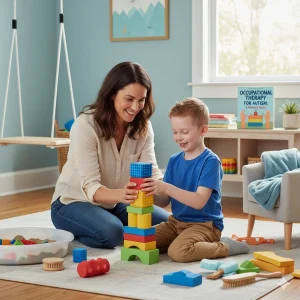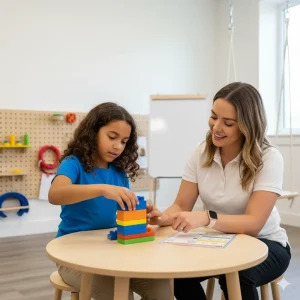Benefits of Occupational Therapy for Adults You Need to Know
By Prapoorna M
Last Updated: October 22, 2024
Have you ever found yourself or a loved one struggling with everyday tasks due to a physical or mental health issue? Occupational therapy might be the solution you need. This type of therapy is designed to help people of all ages develop, maintain, or regain the skills necessary for daily living and working.
Occupational therapy is not just for the elderly or those recovering from surgery; it benefits anyone who needs help with basic activities of daily living (ADLs) such as eating, dressing, or bathing, and instrumental activities of daily living (IADLs) like driving, meal preparation, or managing finances. By working with an occupational therapist, individuals can improve their ability to perform these tasks independently, which significantly enhances their quality of life.
Book Free Occupational Therapy Consultation
Understanding Occupational Therapy
Occupational therapy is a client-centered health profession focused on enabling individuals to participate in the activities of everyday life. Occupational therapists work with people of all ages to help them overcome physical, mental, or cognitive challenges, allowing them to perform essential daily tasks and improve their overall quality of life.
What Are ADLs and IADLs?
To better understand the role of occupational therapy, it’s important to distinguish between basic and instrumental activities of daily living (ADLs and IADLs):
- Basic Activities of Daily Living (ADLs): These are fundamental self-care tasks that include eating, dressing, grooming, using the restroom, and bathing. ADLs are essential for maintaining personal hygiene and physical health.
- Instrumental Activities of Daily Living (IADLs): These tasks are more complex and involve managing an independent household. Examples include cooking, cleaning, managing finances, driving, shopping, and taking medications. IADLs are crucial for living independently and participating in community life.
Also read: Online Occupational Therapy for Kids and Adults
Key Benefits of Occupational Therapy
Improving Range of Motion and Strength
Occupational therapy plays a crucial role in helping individuals restore joint movement and build muscle strength. This is particularly beneficial for those recovering from surgery, dealing with arthritis, or experiencing mobility issues due to aging or injury.
How Does It Work?
- Passive Range of Motion Exercises: These exercises involve the therapist moving the patient’s joints through their full range of motion without any effort from the patient. This helps maintain flexibility and prevent stiffness, especially in cases where the patient cannot move the joint independently.
- Active Assistive Range of Motion Exercises: In these exercises, the therapist provides some assistance while the patient actively moves the joint. This is beneficial for building strength gradually and ensuring proper movement patterns.
- Active Range of Motion Exercises: These exercises require the patient to move their joints independently without assistance. They are crucial for building strength and improving coordination.
- Strengthening Exercises: Occupational therapists design specific exercises to target weak muscles, helping to build strength and endurance. These exercises can range from simple resistance band workouts to more complex weight-bearing activities.
Example: Imagine a patient recovering from shoulder surgery. Initially, the therapist may perform passive range of motion exercises to keep the shoulder joint flexible. As the patient progresses, they might move on to active assistive exercises, gradually building strength. Eventually, the patient will be able to perform active range of motion exercises independently, restoring full function to their shoulder.
Decreasing Pain While Building Strength
Pain management is another key benefit of occupational therapy. Therapists use various techniques to reduce pain while simultaneously building strength.
How Does It Work?
- Stretching Techniques: Stretching helps to alleviate muscle tightness and improve flexibility, which can reduce pain. Occupational therapists guide patients through specific stretches tailored to their needs.
- Manual Exercises: These are therapist-led exercises that help improve joint mobility and muscle strength. By performing these exercises under the guidance of a therapist, patients can avoid improper movements that may cause further pain.
- Newton’s 3rd Law of Motion: This law states that for every action, there is an equal and opposite reaction. In the context of occupational therapy, it means that compensatory techniques (like using one muscle group to compensate for the weakness of another) can lead to imbalances and pain. Therapists teach patients how to perform movements correctly to avoid such issues.
Example: Consider a patient with chronic shoulder pain due to muscle imbalances. The therapist might use manual exercises to strengthen the weak muscles while teaching the patient proper movement patterns to avoid further pain.
Providing Adaptive Strategies and Equipment
Occupational therapy also focuses on providing adaptive strategies and equipment to help individuals perform daily tasks independently.
How Does It Work?
- Adaptive Strategies: These include techniques like energy conservation, which involves planning and pacing activities to prevent fatigue. For example, an occupational therapist might suggest sitting down while preparing meals to conserve energy.
- Adaptive Equipment: Tools such as jar openers, shower chairs, and grab bars can make daily tasks easier and safer. Occupational therapists assess each individual’s needs and recommend appropriate equipment.
Example: A person with arthritis may struggle to open jars due to weak grip strength. An occupational therapist might recommend a jar opener to make this task easier, thereby promoting independence.
Enhancing Visual Skills
Visual impairments can significantly impact daily life. Occupational therapy offers techniques to enhance visual skills and compensate for vision loss.
How Does It Work?
- Scanning Techniques: These involve teaching patients to systematically scan their environment to compensate for vision loss, such as turning the head to view peripheral areas.
- Pre-reading Strategies: These techniques help individuals with visual impairments to read more effectively. For instance, using a ruler to guide the eyes along a line of text can improve reading accuracy.
Example: A stroke patient with partial vision loss may learn scanning techniques to navigate their home safely, reducing the risk of falls.
Conducting Home Safety Assessments
Home safety is paramount, especially for individuals with physical or cognitive impairments. Occupational therapists conduct thorough home safety assessments to identify potential hazards and recommend modifications.
How Does It Work?
- Evaluations: Therapists assess the home environment for risks such as clutter, poor lighting, and unsafe flooring.
- Modifications: Recommendations may include installing handrails, using slip-resistant flooring, and adding grab bars in the bathroom.
Example: An elderly person at risk of falling might benefit from handrails along staircases and slip-resistant mats in the bathroom, enhancing their safety and independence.
Supporting Memory Rehabilitation
Memory issues can greatly affect daily functioning. Occupational therapy includes activities and techniques to enhance memory and cognitive skills.
How Does It Work?
- Memory-enhancing Activities: These activities, such as puzzles and memory games, help to stimulate cognitive function and improve memory retention.
- Techniques for Cognitive Impairments: Occupational therapists use strategies like mnemonic devices and structured routines to help individuals manage daily tasks more effectively.
Example: A patient with early-stage dementia might engage in memory games to maintain cognitive function and use a daily planner to keep track of important tasks.
Offering Caregiver Training and Support
Caring for a loved one can be challenging. Occupational therapists provide valuable training and resources to help caregivers support their loved ones effectively.
How Does It Work?
- Training: Caregivers learn techniques to assist with daily tasks, manage behaviors, and provide appropriate care.
- Resources: Therapists offer information on community resources, support groups, and educational materials to help caregivers cope with their responsibilities.
Example: A caregiver for a person with Parkinson’s disease might learn how to assist with mobility exercises and manage medication schedules, ensuring better care for their loved one.
Preventing Falls
Falls are a major concern, especially for the elderly. Occupational therapists teach balance and muscle-strengthening exercises to reduce fall risks.
How Does It Work?
- Balance Exercises: These exercises improve stability and coordination, reducing the likelihood of falls.
- Strengthening Exercises: Building muscle strength helps to support joints and improve overall mobility, further decreasing fall risk.
Example: An elderly person might participate in a balance training program to improve their stability, making it safer for them to walk unaided.
Facilitating Better Outlook on Life
Occupational therapy helps improve mental health and overall outlook by encouraging participation in meaningful activities.
How Does It Work?
- Engaging Activities: Therapists encourage individuals to engage in hobbies and social activities that bring joy and fulfillment.
- Mental Health Support: Occupational therapy includes techniques to manage stress and promote a positive mindset.
Example: A person recovering from depression might be encouraged to participate in art classes or gardening, activities that provide a sense of accomplishment and improve mood.
Aiding Life Transitions
Life transitions, such as retirement, can be challenging. Occupational therapists provide support to help individuals navigate these changes.
How Does It Work?
- Coping Strategies: Therapists teach techniques to manage emotions and adapt to new circumstances.
- Support Systems: Building a network of support, including family, friends, and community resources, helps individuals through transitions.
Example: An elderly person adjusting to life after the loss of a spouse might receive counseling and be encouraged to join a support group, helping them to cope with their grief and find new purpose.
Making Home Modifications for Safety
Ensuring a safe living environment is crucial for maintaining independence. Occupational therapists recommend home modifications to enhance safety.
How Does It Work?
- Assessment: Therapists evaluate the home for potential hazards and areas that need improvement.
- Modifications: Recommendations may include installing grab bars, improving lighting, and removing trip hazards.
Example: A person with limited mobility might benefit from a wheelchair ramp and wider doorways, making it easier to move around the home safely.
Assisting with Vision Loss
Occupational therapy provides strategies to help individuals cope with vision loss and maintain independence.
How Does It Work?
- Environmental Adjustments: Changes such as better lighting and color contrast can make it easier to navigate the home.
- Assistive Devices: Tools like magnifiers and talking clocks help individuals manage daily tasks despite vision impairments.
Example: An elderly person with macular degeneration might use a magnifying glass for reading and bright tape on stairs to prevent falls.
Recommending Techniques for Dementia Patients
Dementia patients benefit from specialized techniques to maintain their quality of life.
How Does It Work?
- Behavioral Strategies: Techniques such as redirection and validation help manage challenging behaviors.
- Routine Establishment: Creating structured routines helps dementia patients navigate their day with less confusion.
Example: A dementia patient might follow a daily schedule with visual cues to remember tasks like eating and bathing, reducing anxiety and improving daily functioning.
Being a Trusted Confidant
Occupational therapists serve as supportive confidants, providing emotional and practical support.
How Does It Work?
- Building Trust: Therapists develop strong relationships with patients, offering a safe space for them to express concerns.
- Emotional Support: Providing a listening ear and guidance helps patients feel understood and less isolated.
Example: An elderly person feeling lonely and depressed might find comfort in regular sessions with an occupational therapist, who offers both practical advice and emotional support.
Improving Range of Motion and Strength
Occupational therapy plays a crucial role in helping individuals restore joint movement and build muscle strength. This is particularly beneficial for those recovering from surgery, dealing with arthritis, or experiencing mobility issues due to aging or injury.
How Does It Work?
- Passive Range of Motion Exercises: These exercises involve the therapist moving the patient’s joints through their full range of motion without any effort from the patient. This helps maintain flexibility and prevent stiffness, especially in cases where the patient cannot move the joint independently.
- Active Assistive Range of Motion Exercises: In these exercises, the therapist provides some assistance while the patient actively moves the joint. This is beneficial for building strength gradually and ensuring proper movement patterns.
- Active Range of Motion Exercises: These exercises require the patient to move their joints independently without assistance. They are crucial for building strength and improving coordination.
- Strengthening Exercises: Occupational therapists design specific exercises to target weak muscles, helping to build strength and endurance. These exercises can range from simple resistance band workouts to more complex weight-bearing activities.
Example: Imagine a patient recovering from shoulder surgery. Initially, the therapist may perform passive range of motion exercises to keep the shoulder joint flexible. As the patient progresses, they might move on to active assistive exercises, gradually building strength. Eventually, the patient will be able to perform active range of motion exercises independently, restoring full function to their shoulder.
Techniques for Improving Range of Motion and Strength
| Technique | Description |
|---|---|
| Passive Range of Motion | The therapist moves the patient’s joints through their full range of motion without any effort from the patient. This helps maintain flexibility and prevent stiffness, particularly useful for patients who cannot move their joints independently. |
| Active Assistive Range of Motion | The patient actively moves their joints with some assistance from the therapist. This technique helps build strength gradually while ensuring proper movement patterns, beneficial during the recovery phase. |
| Active Range of Motion | The patient moves their joints independently without any assistance. This technique is crucial for building muscle strength and improving coordination, often used in later stages of recovery. |
| Strengthening Exercises | These exercises target weak muscles to build strength and endurance. They can range from simple resistance band workouts to more complex weight-bearing activities, tailored to the patient’s specific needs. |
Providing Adaptive Strategies and Equipment
Occupational therapy also focuses on providing adaptive strategies and equipment to help individuals perform daily tasks independently.
How Does It Work?
- Adaptive Strategies: These include techniques like energy conservation, which involves planning and pacing activities to prevent fatigue. For example, an occupational therapist might suggest sitting down while preparing meals to conserve energy.
- Adaptive Equipment: Tools such as jar openers, shower chairs, and grab bars can make daily tasks easier and safer. Occupational therapists assess each individual’s needs and recommend appropriate equipment.
Example: A person with arthritis may struggle to open jars due to weak grip strength. An occupational therapist might recommend a jar opener to make this task easier, thereby promoting independence.
Enhancing Visual Skills
Visual impairments can significantly impact daily life. Occupational therapy offers techniques to enhance visual skills and compensate for vision loss.
How Does It Work?
- Scanning Techniques: These involve teaching patients to systematically scan their environment to compensate for vision loss, such as turning the head to view peripheral areas.
- Pre-reading Strategies: These techniques help individuals with visual impairments to read more effectively. For instance, using a ruler to guide the eyes along a line of text can improve reading accuracy.
Example: A stroke patient with partial vision loss may learn scanning techniques to navigate their home safely, reducing the risk of falls.
Also read: How Occupational Therapy Helps with Autism
Conclusion
Occupational therapy can be a life-changing journey toward greater independence and improved well-being. With personalized care at Wellness Hub, you can regain mobility, enhance memory and visual skills, and learn strategies to make daily tasks easier. Our experienced therapists are committed to helping you or your loved ones overcome physical or cognitive challenges. Take the first step towards better health and explore the transformative benefits of occupational therapy. Contact Wellness Hub today to start your journey to a more independent and fulfilling life. Together, we can make a difference.
Frequently Asked Questions:
1. What are the primary benefits of occupational therapy?
Occupational therapy helps individuals improve joint movement and muscle strength, reduce pain, enhance visual and memory skills, and perform daily activities independently. It also provides support for caregivers and ensures home safety through personalized assessments and modifications.
2. How does occupational therapy help with pain management?
Occupational therapists use stretching techniques and manual exercises to reduce pain. They also teach patients proper movement patterns to avoid muscle imbalances and pain caused by compensatory techniques.
3. What types of adaptive equipment are used in occupational therapy?
Adaptive equipment includes tools like jar openers, shower chairs, grab bars, and other devices that make daily tasks easier and safer. These tools help individuals perform activities independently and comfortably.
4. Can occupational therapy improve cognitive skills?
Yes, occupational therapy includes memory-enhancing activities and cognitive exercises to improve memory and cognitive function. Therapists also use strategies like mnemonic devices and structured routines to help individuals manage daily tasks more effectively.
5. How does occupational therapy support caregivers?
Occupational therapists provide training and resources to help caregivers support their loved ones effectively. This includes teaching techniques to assist with daily tasks, manage behaviors, and provide appropriate care, as well as offering information on community resources and support groups.
6. What home modifications are recommended by occupational therapists?
Home modifications may include installing handrails, using slip-resistant flooring, adding grab bars in bathrooms, and making other adjustments to ensure safety and promote independent living. These modifications help reduce the risk of falls and other accidents at home.
7. How does occupational therapy help with vision impairments?
Occupational therapists teach techniques like scanning and pre-reading strategies to help individuals with visual impairments. They also recommend environmental adjustments such as better lighting, color-coded labels, and assistive devices like magnifiers.
8. Is occupational therapy beneficial for dementia patients?
Yes, occupational therapy provides specialized techniques to support dementia patients, such as behavioral strategies, routine establishment, and cognitive exercises. These techniques help maintain their quality of life and reduce confusion.
9. How can occupational therapy improve the quality of life for elderly individuals?
Occupational therapy helps elderly individuals regain independence, perform daily activities, and manage age-related challenges. It offers personalized care plans that include exercises, adaptive strategies, and home modifications to enhance their overall well-being.
10. Where can I find occupational therapy services?
At Wellness Hub, we offer personalized occupational therapy services tailored to your unique needs. Our experienced therapists are dedicated to helping you achieve better health and independence. Visit our website to learn more and get started on your journey to improved well-being.
About Author
Prapoorna Mangalampalli
M.Sc., M.A., (Dual Masters in Psychology & English) – Counselor (6+ years of experience)
Prapoorna is a skilled counselor with dual Master’s degrees in Psychology and English. With more than six years of professional experience, she specializes in providing various types of counseling, including online Therapy , Marital , Relationship, child, family, and career counseling. Prapoorna is part of the Wellness Hub team, where she contributes significantly to their mission. She values a team-based approach and is committed to innovation, compassion, and the success of her clients. Her diverse educational background and extensive experience enable her to offer insightful and effective counseling services that positively impact individuals and families.
Book your Free Consultation Today
Parent/Caregiver Info:
Client’s Details:
* Error Message









